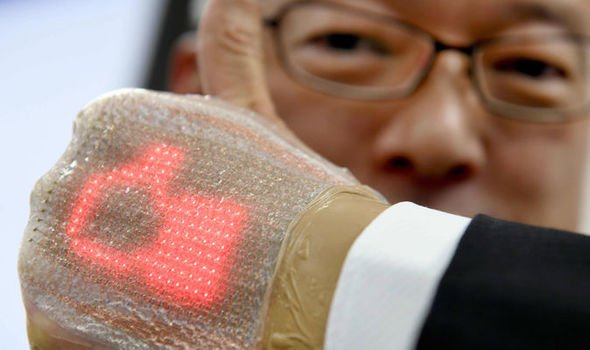'Electric skin' which 'feels like part of your body' set to TRANSFORM healthcare industry

The developers are hoping that the device, which can be used to take body readings and receive messages, could be helpful for doctors with patients living in faraway places or family living far from their relatives.
The system could ease the strain on healthcare systems in ageing societies through this form of non-invasive health monitoring.
The researchers from the University of Tokyo and Dai Nippon Printing revealed the new device at the annual meeting of the American Association for the Advancement of Science in Austin, Texas, on Saturday.
The LED display consists of a one-millimetre-thick rubber sheet embedded with 400 micro-LEDs that can be stretched and twisted without the circuit breaking.
The device could be used to remind patients to take their medicine or allow grandchildren to communicate with their grandparents far away.
The data can be shared to a smartphone or the cloud, and the display can also send and receive messages, including emojis.
Professor Takao Someya, one of the project leaders, said: “With this, even in home-care settings, you can achieve seamless sharing of medical data with your home doctors, who then would be able to communicate back to their patients.
“The device displays on your skin, and you would feel as if it is part of your body. When you have messages sent to your hand, you would feel emotional closeness to the sender.
“I think a grandfather who receives a message saying ‘I love you’ from his grandchild would feel the warmth, too.”
Advances in semiconductor technology has meant that the wearable devices can now monitor health by measuring vital signs and then transmitting the data wirelessly to a smartphone.
Mr Someya said: “Our display exhibits simple graphics with motion.
“Because it is made from thin and soft materials, it can be deformed freely.
(html comment removed: Start of Brightcove iframe Player )”The skin sensor can be worn on the skin for a week without causing any inflammation.
Mr Someya said: “The current ageing society requires user-friendly wearable sensors for monitoring patient vitals in order to reduce the burden on patients and family members providing nursing care.”
The device could be on the market by 2021.
Follow @davidlanz for real-time crypto news!